Pinkbike's EWS Pro Rides: Fabien Barel's Canyon Strive
What to say about Fabien Barel? He's the master of comebacks, pusher of boundaries and a man of particular precision. He's been around forever, has been adorned with rainbow stripes from the downhill World Championships on three occasions, and worn the French national jersey for six years. During those times, he's faced some brutal injuries, followed by rapid resurgences. Living next door to Nicolas 'The Alien' Vouilloz in the French Maritime-Alps, it comes as no surprise that he shares similar method and meticulous approach as the ten-times World Champ.
Turning his focus to enduro in 2013, Fab stood atop the first ever EWS podium on the Tuscan beach front in Punta Ala, Italy. After a broken back in Nevados de Chillan last year, he was forced to sit, or lie out the heart of the season, only to return to Finale Ligure and take the top step again - a different venue, but he sure seems comfortable on Italian Riviera. At the fourth round of this year's EWS in Samoens, France, he admitted being off the pace on stage one and faced a 40-second deficit that needed deferral over the following days. He showed his toughness by taking wins on stages four, five and six, but unfortunately couldn't claw back enough rungs to get to the top step, eventually settling into third place. No mean feat. As quickly as the event rolled in to the quaint French town, it shipped out, as riders headed to Colorado in search of acclimatization, I never got to ride Fabien's personal Canyon Strive. Nonetheless, Fabien always has plenty to say, so I provoked him with: "Can you talk about your bike setup?" and let him loose.
Fabien's Basics
The Frenchman stands at 1.81 meters and weighs 79kg. There must be some serious muscle mass hidden away somewhere because he doesn't look like a big guy, and certainly isn't carrying any extra pounds around his waist. He rides a Canyon Strive carbon in a 'Large Race' size, uses a 10mm rise Renthal Fatbar 780mm Carbon handlebar, matched with a 40mm stem. Chainring size is pretty normal, at 34 teeth on a 175mm crankarm, powering a SRAM 11-speed drivetrain.
RockShox takes care of Fabien's damping duties, with a Lyrik fork leading the charge and a Monarch XX shock. Barel’s 90psi setting puts the fork at 30-percent sag in riding position, with three Bottomless Tokens for the big impacts. Between 180 and 190psi gives 30 to 35-percent sag for the Monarch XX shock, which has seven volume spacers installed and a handlebar-mounted lockout. Tire pressures are generally around 27psi front and 29psi rear.
Bike setup
 This is your first full season since you were injured. How has that affected your bike setup?
This is your first full season since you were injured. How has that affected your bike setup?So, things have been changing a lot over the last few years due to my back - injuring my back last year and also, my leg three years ago. I have been changing quite a few things in terms of saddle height, handlebar height and even handlebar width, based on the races we have.
Something I have learnt from my experiences moving to enduro is that, generally, the handlebar height is lower than what we would have in downhill, because to load the front end and have good direction on all the flat terrain and singletrack is something that we clearly need. As I'm riding a fairly long bike that has a large influence on my body position and general mass, I move around the bike.
For example, for Scotland and Ireland, I did lower my handlebar quite a bit, but also narrowed it down to 770mm to actually help me around the trees because everything was fairly tight. Samoens showed us a lot of steepness (except in Stage 1), then a lot of endurance skills, due to the length and steepness of the tracks. I quickly realized I needed to get back in to more of a DH position. So, first of all I changed to a new Lyrik fork that was 13mm higher than the Pike, and I brought my handlebar one centimeter higher too. So, 23mm higher than I had been riding in the previous two rounds, and also went back to a 785mm handlebar to give more stability and comfort when loading the front wheel into the steeps.
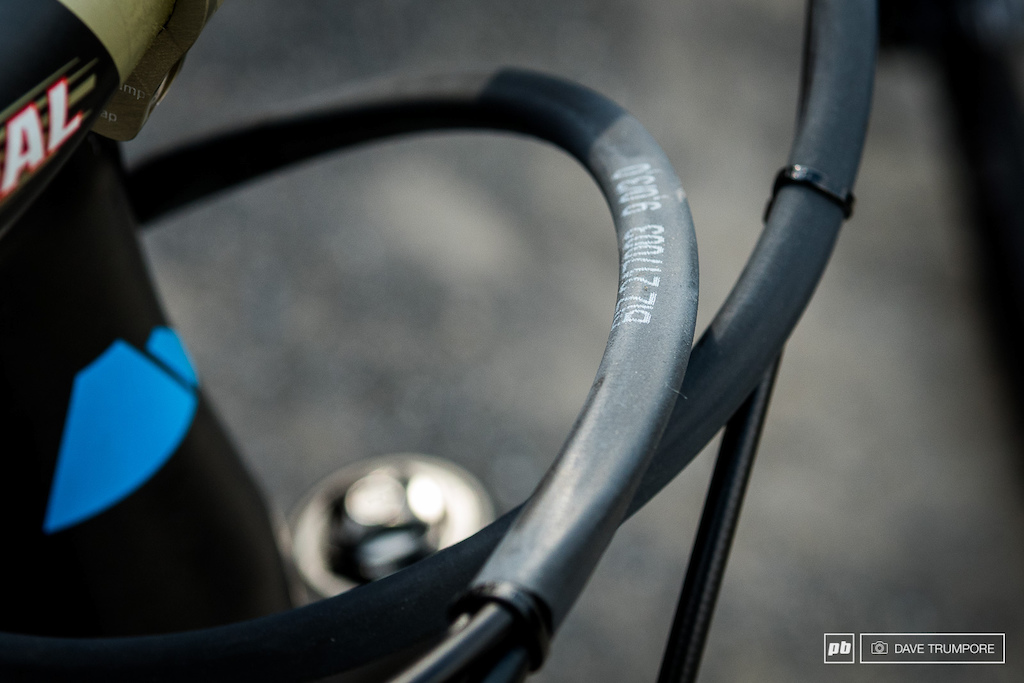
Fab's mechanic threads the hoses and cable through electrician's shrink-tubing to keep it the front end quiet and neat.
Coming in to suspension settings, we obviously have two different options for to keep the height in the travel while riding - the spring force or the damping. What people need to know is that for sure damping is helping to keep you carrying more speed forward, when you absorb impacts, but is creating a lot more harshness through your body and so, using more energy. Less damping and more spring force is actually allowing you to keep the ride height, but still allows the bike to be more supple and obviously requires a little more balance on the bike, but you gain a lot in traction and comfort and you have a bike that is allowing you to make more mistakes by the fact that the suspension is a lot more active under your legs. For Samoens I used quite a bit of spring force, and used the option we have on the new Lyrik, with the negative chamber, to give us a lot of traction on the front wheel. We softened the suspension in terms of damping. This allowed me to absorb more mistakes and give me more control on the long tracks.
 Can you expand more on the changes you made with after your back injury?
Can you expand more on the changes you made with after your back injury? Yeah, I had to modify a lot of things because of the fact that most of your energy when riding and generally in sport is started and driven from your spine. Your head, arms and legs are completely connected to your back with the nerves and that's how you drive a movement, rather than using strength from one muscle. Based on this, I had to change the bike to make my back a lot straighter and so I was not absorbing forces with a bent back and putting pressure on the bones that I had broken. I lowered my saddle and had to learn to pedal with my heels down a lot further than I was used to. I had to play around with the handlebar height and width to give me the comfort I needed and, dependent upon the roughness of the terrain, It took a lot of work to not get any back pain on long stages or many days of racing consecutively.
 Do you get pain on the transfers or in the actual race stages?
Do you get pain on the transfers or in the actual race stages? On the liaisons, I normally get time to position myself where I want to on the bike. I can play a bit with the Reverb dropper to get the exact seat height I want for comfort. But, mainly in the stage when I get the pain, I try to release the muscles as much as I can so my spine and bones aren't taking a load that they shouldn't. Especially when it's rough, I lift the handlebars. I have also changed my saddle position. I used to have my hips rolled back for pedaling more with my quads. Now, due to my back, I have to have my hips rolled a lot more forward and I'm using the hamstrings much more than before.
Brakes and Wheels
 What brakes are you using and how do you set them up?
What brakes are you using and how do you set them up? With the brakes, we have done quite a bit of testing with the new SRAM Guide Ultimates. I went to a 200mm rotor at the front for the steepness, just to give comfort and efficiency. Thanks to the hydraulic stability we have with the Ultimate, I managed to stick with the organic pads and a 180mm disc on the rear. For me that was sufficient to control the bike.
 What about wheel and tire choice?
What about wheel and tire choice? I am riding the new Mavic CrossMax wheels which are 23mm internal width front and rear. Between day one and day two we changed to a dryer condition tire. On stage one, we needed more control on the greasy dirt that we found after the storm. I also softened the fork a little for that stage to try and get more control over the front.
 Any special tubeless settings?
Any special tubeless settings? Pretty standard. I am using between 900g and 1200g tires, I rarely go above or below, depending on the carcass and what I expect from the tire, always starting with 27psi front and 29psi rear. I use 100ml to 150ml of tubeless sealant, depending upon the kind of terrain we have. The 23mm rim is the only permanent and I play in between those settings. I rode a 1200g tire on the front on day one with 100ml of sealant. On the second day I went for a slightly smaller tire with 150ml of sealant, based on the fact it was dry, but faster. You didn't need exactly the same type of tires.
 Does the volume of sealant make a big difference?
Does the volume of sealant make a big difference? It makes a difference in terms of puncture risk and weight. The size of the hole you could expect to put in to a tire from the type of terrain, and for the pedaling and dynamism of the bike. If you have a lot of rocks and you expect a lot of cuts on the side or top part of the tire, that's when you need more sealant. When it's only grassy and you're looking out for thorns and perhaps a pinch, you can go for a lower volume of sealant.
 Can you feel the difference between the volumes?
Can you feel the difference between the volumes? Well I can make up to 100 grams of difference to the rotating mass. I wouldn't say that you can feel it when riding the bike but I do know mechanically there could be an advantage or not. I think if I change the rotating mass by 200 grams I can start to feel it. Below that it's kind of hard to feel.
Suspension
 I noticed you're not using a Monarch Plus like most of the RockShox supported racers?
I noticed you're not using a Monarch Plus like most of the RockShox supported racers? I am using a Monarch XX rear shock, which has no piggyback, but has a lockout which I use on flat, fast sections. The Shapeshifter is a huge advantage on stage one for example where you have a long climb and flat sections where you can use it in climb mode all the way. But, for example where we had the 4x4 track on the end of stage five where it was really fast, you don't want to make the geometry steeper because you're going fast, but you also don't want the suspension to lose some of your pedaling energy to carry speed. That's when I use the lockout.
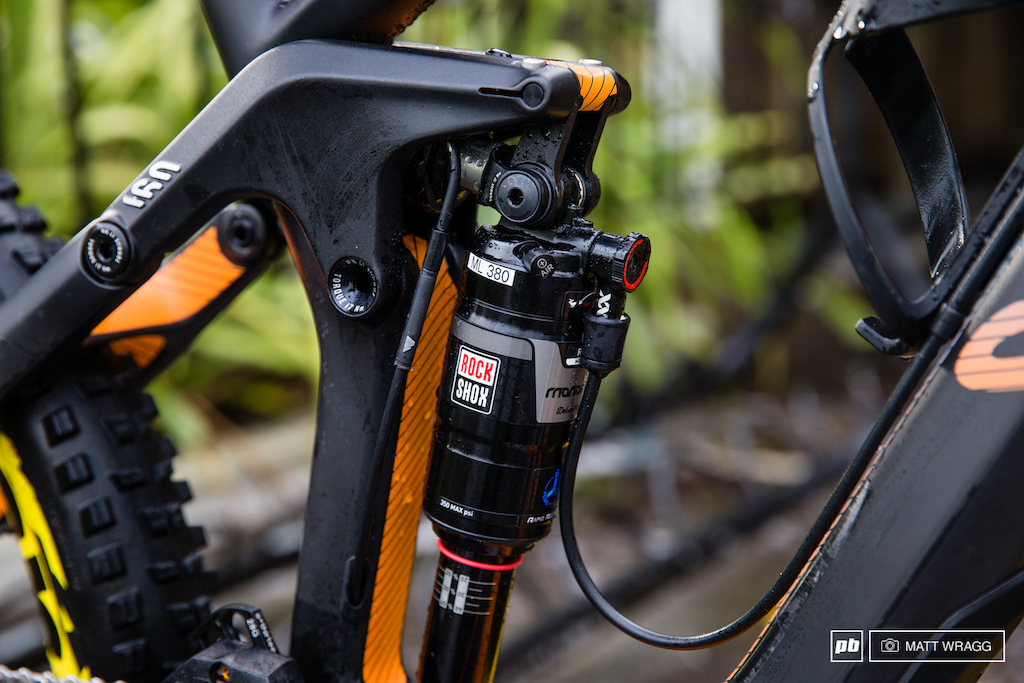
A RockShox Monarch XX for putting the power down, while keeping the geometry raked out for high speeds.
 Is it a complete lockout?
Is it a complete lockout? No. I would say about 85-percent. We have the advantage to be able to set this on the shock. It's not ideal for high temperature, because the rebound changes quite a lot by the bottom of the run with the heat. For example; in stage two, this was an issue. To anticipate this, I started my run with a little more rebound than I would normally have, to end up in the setting I want towards the bottom, when I was tired. It's something you need to anticipate.
 Do you know if the sag changes much with the heat? Nico Vouilloz mentioned this in New Zealand?
Do you know if the sag changes much with the heat? Nico Vouilloz mentioned this in New Zealand? No, not really, it's mainly the rebound activity that is changing. You end up with a bike that is much more active under your legs as you lose rebound control, but I don't think the air pressure is noticeably changing in terms of bike position. Just because it makes it more active and supple, you need to control the bike a lot more with your legs, because the suspension is not providing you with the stability you need. And that's maybe why the wobbling is bringing you into the travel deeper than it should be. But the sag setting is not really changing on my bike.
 What do you mean by wobbling?
What do you mean by wobbling? I mean, you know when you don't have much hydraulic control and only based on the spring force you actually feel the bike moving a lot under your legs and you have a lot of oscillation of the suspension before it re-stabilizes after an impact. Basically, in normal situations, this oscillation is controlled by the hydraulics. When it overheats, that's when you get in to trouble - having to control the feedback of your bike with your legs, compared to what to terrain is giving you.
 Did you have any different setting for different stages?
Did you have any different setting for different stages? I mainly changed between stage one and going in to the following stages, because all the other stages were more punchy and needed pure downhill skill, endurance, and sprints compared to stage one. The main changes for me definitely came in stage one.
 Had you already chosen the settings, or did you make decisions after the practice runs?
Had you already chosen the settings, or did you make decisions after the practice runs? We have a few things that we test ahead of the races to use as a reference - heights, widths, suspension set up - and we base on our training, what would be optimum. Basically, we use those to anticipate what changes to make after the practice run. For example; Stage 1 was the most challenging. We practiced in the dry, but the race was in the wet. So, we had to think, imagine, and anticipate based on our experience, to choose tires, pressures, suspension, handlebar height,, and all this to optimize things. We had the chance at this race to come back to the pits to modify things between runs, which is not the case on most races.
 Is all the suspension stock?
Is all the suspension stock? We have a special tune on the Monarch XX shock. Actually, two special tunes that we have been developing this winter and one, more recently, that I have been playing with on the rear shock. The fork is a completely stock cartridge with normal Lyrik settings. We just try to optimize as much as we can, the friction. We work with RockShox to make sure to use the correct oil in certain places between the seals and bushings, and keeping on top of the servicing all the time - a full service, two times in a two-day race.
Miscellaneous
 Is it true that you have one leg that's shorter than the other?
Is it true that you have one leg that's shorter than the other? My left leg is three centimeters shorter since I broke my femur! I have one shoe that is bigger than the other, basically my short leg has a shoe that is one centimeter higher than the other and I compensate on the bike and general life with a one centimeter difference, I got used to it with the movement of my hips. Mavic made a special shoe for me to be able to kind of walk straight and not just around in circles.
 Do you use a power meter?
Do you use a power meter? Yes. I do use a power meter. I use one to train just since the start of this winter. It's been interesting to start using this. It's tough to compare between the road and mountain bike though. Most of the reference testing we do is on the road and when you get on an MTB, you can’t use the same numbers, because of the fact of traction and rolling resistance is very different.
 While racing, do you use any power or heart rate measurements during the runs?
While racing, do you use any power or heart rate measurements during the runs? No. I never use it at the races. I try to get the feeling of where I should be and to control my energy, as you feel different nearly every day based on how you eat, sleep and feel mentally. I don't think that simple numbers can help you to optimize what you need to do in a race. I am definitely basing my reference of energy on my own feeling and not on the computer, that's for sure.
 When you're racing, do you use some strategy, or just send it as fast as you can?
When you're racing, do you use some strategy, or just send it as fast as you can? It really depends on the stages. When you feel that the length of the stage is something you can maintain at a full pace, that's when you can give it all. But on Stage 1, you know that you need to control and set a certain pace, you know where you need to push, or where to conserve energy. You need to save enough energy in reserve to have a clear vision of the track and keep suppleness on the bike.
 Stage 4 was the toughest track of the weekend. What was your approach to that?
Stage 4 was the toughest track of the weekend. What was your approach to that? Clearly, you give it all physically, but technically you are looking for a constant average speed to be good and not taking so much risk. Whereas on Stage 5, it was a lot shorter and the passages that are technical are a lot shorter, so you can commit a lot more. Basically, you have to adapt the intensity of your riding and the intensity of your physical training and capacities, compared to the energy you need to use on the run.
 So, all that on feeling?
So, all that on feeling? Feeling, anticipation, guessing, based on the fact you know the track after the practice. On a different race, like in Colorado, it will be a complete different story - where we don't know the track and the management has to be radically different.
Author Info:
Must Read This Week
[UPDATED] Final Elite XC Results & Overall Standings from the Mairiporã XC World Cup 2024
42051 views
42051 views
Sign Up for the Pinkbike Newsletter - All the Biggest, Most Interesting Stories in your Inbox
PB Newsletter Signup


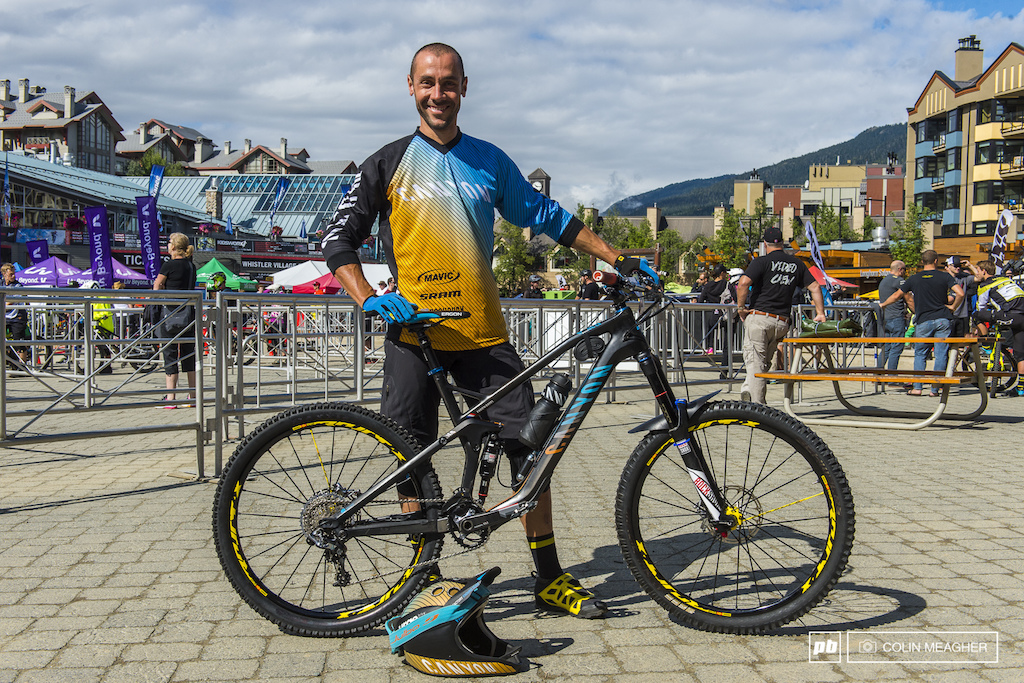
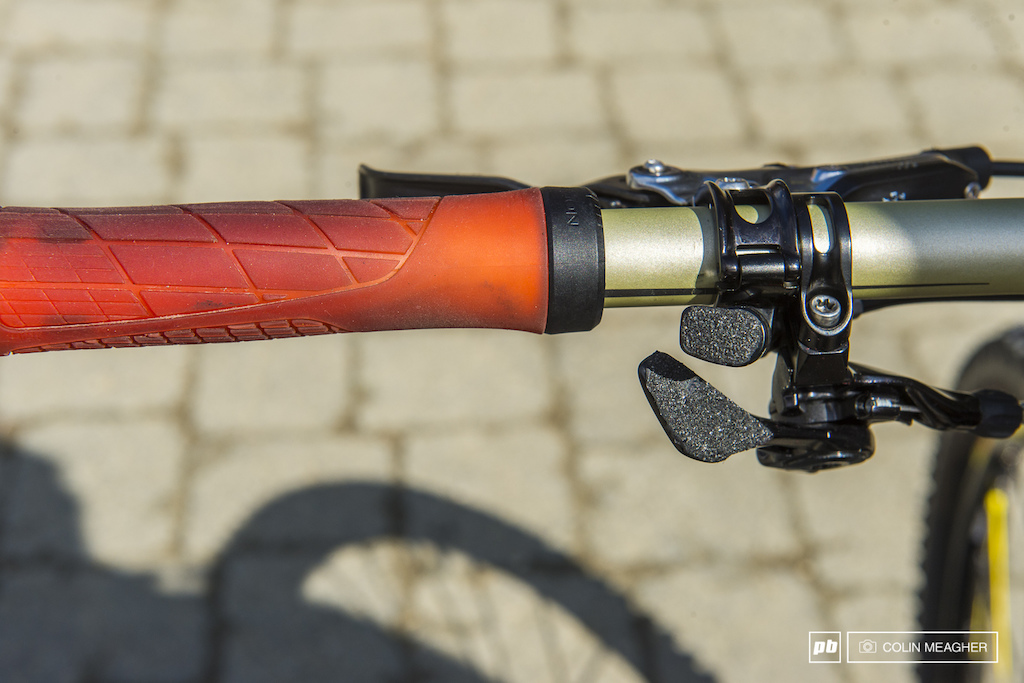

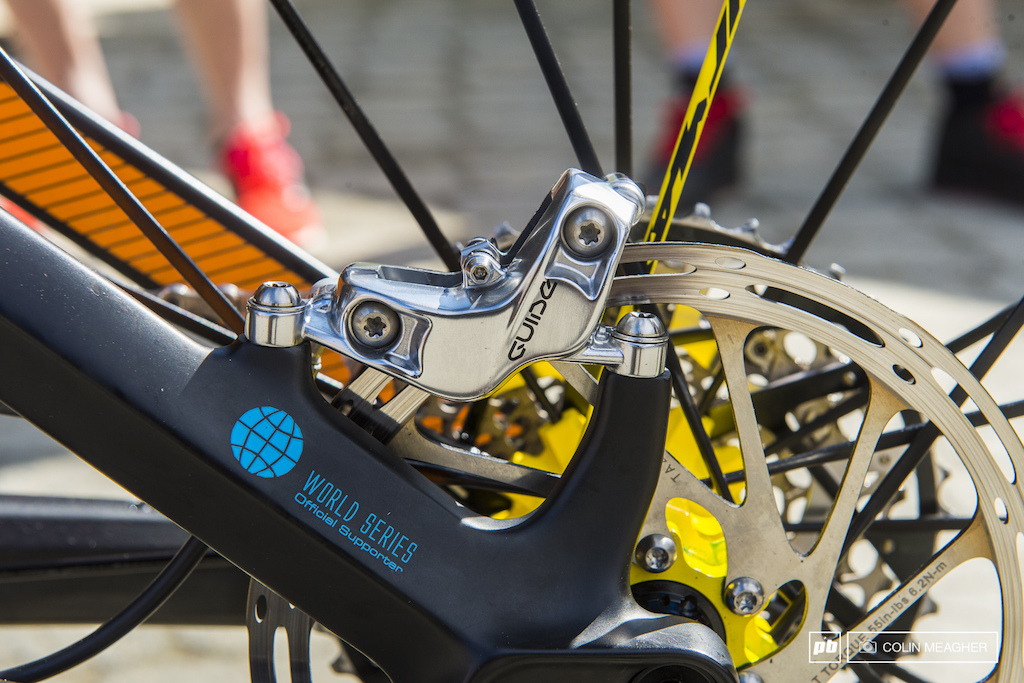
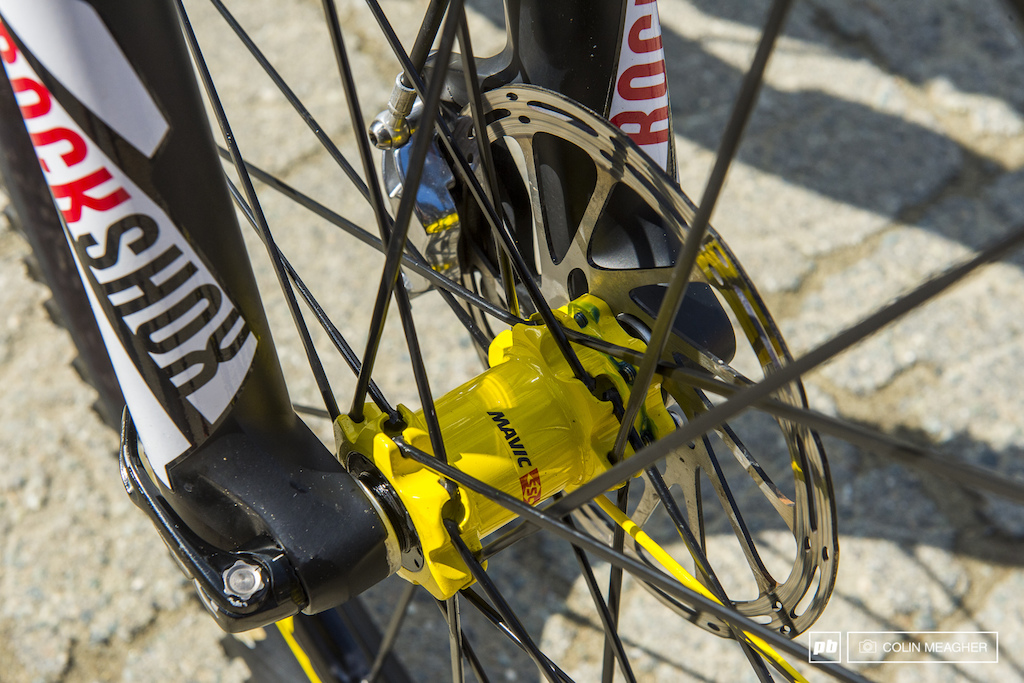




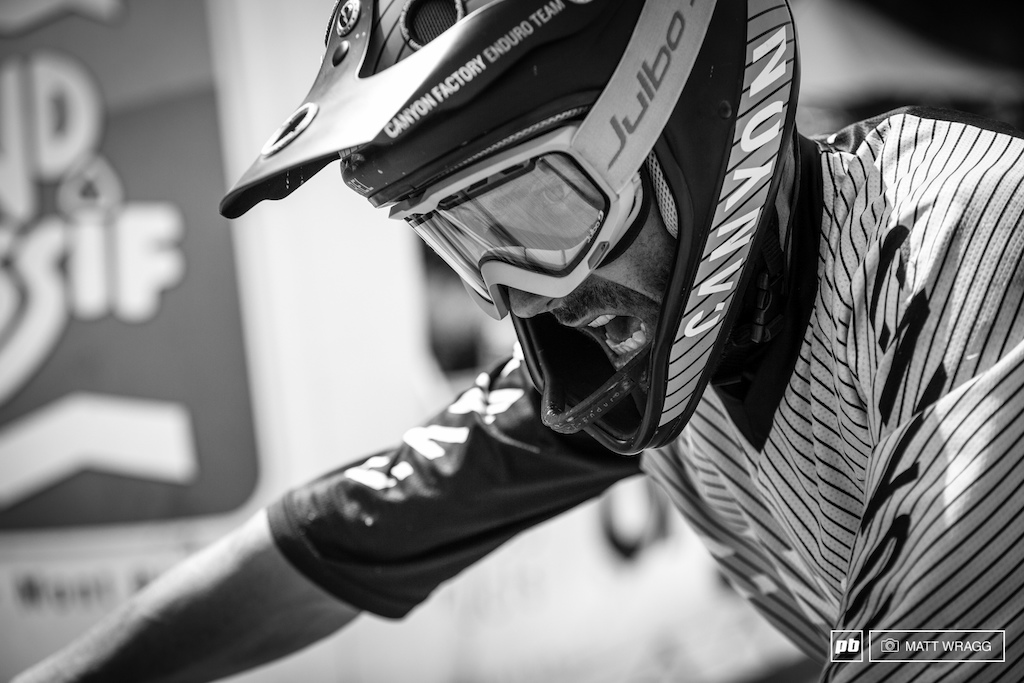

Dear @pinkbikeproductions could we get some video like Bike Magazine, did to Tippie.
youtu.be/uwgZb8HcRkk
Great article, love to read racers analysing their equipment choices.
Compression - when the shock is compressed by a impact to the tires
Rebound - when the shock starts pushing back out and back to its normal length
Damping - slows compression and it also stops it from acting like a pogo stick or trampoline by giving it one solid and fluid compressing motion
Rebound control (aka spring rate) - controls how quickly your shock bounces back from a hit. Too fast and it will buck you off your bike or feel hard, too slow and it will sink through travel on rapid hits because it wasn't able to recover from the (hence RS's deal about rapid recovery mumbo jumbo).
REBOUND DAMPING - Adjustment for the return stroke. More Rebound Damping slows down shaft speed movements (possible packing if too slow, not returning to full travel for next impact) and less Rebound Damping or no Rebound Damping allows the fork to return to full travel as quick as manufacture design allows oil to return through the rebound circuit (not always ideal, pogo stick, loss of traction, kicking).
SPRING RATE - Air fork uses an Air Spring or Air Pressure to support rider weight, Coil Sprung fork uses a Coil Spring uses just that to support the rider weight. Spring rate is expressed as the amount of force required to compress the spring a certain distance. Air spring will fatigue if pushed too hard and will heat up and the shock will firm up as the air pressures increases. Coil spring will remain the same throughout regardless, although may lose some of its memory over years of abuse.
Rebound control is not spring rate as @TFreeman mentioned.
So let me check this - if Fabien is saying that he uses less damping and more spring force to keep the height in the travel but supple over the bumps he is saying that he is running a higher air pressure but with less compression damping.
If I am using a Pike RTC with limited compression settings how would I achieve this?
Currently, I run 70 PSI with 1 token at 175lbs weight. It stays high in the travel and there is usually 20mm of travel left unused which feels good geometry wise but it feels a little harsh on the hands at speed. How can I create a bit more suppleness without losing ride height?
When I had a 160mm Pike I was running 2 tokens at 60psi. I weigh 155lbs. Mostly everything I ride is hard pack rocky, marble scattered terrain that doesn't offer the best traction.
I played with 55-65psi for different trails, but 60psi was a good middle ground.
55 was so good on the smaller stuff that I couldn't even feel the fork cycling through the travel for the first 80mm.
So that setup was good for slower technical trail rides, 65psi was good for jumps drops high speed.
60psi was good at both.
Now I have the DVO Diamond and I like it much more.
"If I am using a Pike RTC with limited compression settings how would I achieve this?"
He is probably using a custom shim stack that allows oil to flow in a way us mere mortals will likely never feel. Since you have the OEM RC Pike, when you open up your dial all the way counter-clockwise, that is the least amount of damping you can achieve. So the only way to achieve less damping is to pull the shim stack and drop in a custom setup, although probably isn't necessary. I would try dropping 5 psi and adding another token, even though does nothing to your damping system it may help and it doesn't hurt to try.
"How can I create a bit more suppleness without losing ride height?"
Exactly the same answer and before, if you let 5 psi out, you will feel a major difference. You may bottom, it depends.
Try letting 5psi out with your current 1 token.
5psi with 2 tokens.
10psi with 2 tokens
10psi with 3 tokens.
Keep playing with it till you find your sweet spot.
wideopenmag.co.uk/2013/06/trek-world-racing-unleash-the-hot-box-what-do-you-think
It has to go to another country. Cant even pay with a US card or bank. I wouldnt do it again
No picture of the tunned tyre...
Not allowed tonride his bike the interviewer this time?
Customers themselves are trying .
What the hell are you doing?